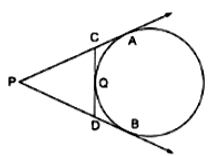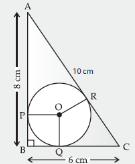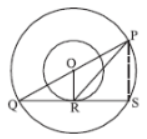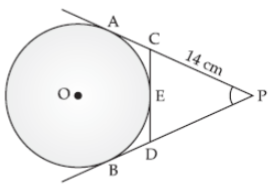Table of Contents


Ans.(b) 9 cm
Explanation:
Since, PA and PB are tangents to the circle from point P.
Therefore PA = PB …(i)
Also, CD is the tangent touching the circle at Q.
Therefore, CA = CQ and DQ = DB …(ii)
Since, tangents from external points are equal.
Now, PA = PB = 12 cm
CA = CQ = 3 cm
PC = PA - CA
= 12 - 3 = 9 cm.
Ans. (b) 2 cm
Explanation:
An incircle is drawn with centre O which touches the sides of the triangle ABC at P, Q and R. OP, OQ and OR are radii and AB, BC and CA are the tangents to the circle.
OP ⊥ AB, OQ ⊥ BC and OR ⊥ CA.
OPBQ is a square. ( ∵ ∠B - 90^o)\\
Let r be the radius of the circle
PB = BQ = r
AR = AP = 8 - r,
CQ = CR = 6 - r
AC = AR + CR
⇒ 10 = 8 - r + 6 - r
⇒ 10 = 14 - 2r
⇒ 2r = 14 - 10 = 4
⇒ r = 2
∴ Radius of the incircle = 2 cm.

Explanation:
Let the line QR intersect the bigger circle at S.
Join PS.
O is the mid-point of PQ. [∵ PQ is a diameter of the bigger circle]
QR is a tangent to the smaller circle and OR is a radius through the point of contact R.

∴ OR ⊥ QR ⇒ OR ⊥ QS
Since, OR is perpendicular to a chord QS of the bigger circle.
∴ QR = RS
[ ∵ Perpendicular from the centre to a chord bisects the chord]
⇒ R is the mid - point of Qs.
∴ In △QSP, O is the mid-point of PQ and R is the mid-point of QS. \\\text{OR} = \dfrac{1}{2} \text{Ps} \\
[∵ segment joining the mid-points of any two sides of a triangle is half of the third side]
⇒ PS = 2OR = 2 × 8 cm = 16 cm
\\
\text{In right △OQR, OR}^2 + QR^2 = OQ^2\\[4.5 bp]
⇒ 8^2 + QR^2 = 13^2\\[4.5 bp]
⇒ 64 + QR^2 = 169\\[4.5 bp]
⇒ QR^2 = 169 – 64 = 105 \\[4.5 bp]
QR = \sqrt{105} \\[4.5 bp]
\therefore \space RS = QR = \sqrt{105}\\[4.5 bp]
\text{In △PRS, PR}^2 = \text{RS}^2\text{ + PS}^2\\[4.5 bp]
= (\sqrt{105})^2 + 16^2\\[4.5 bp]
⇒ PR = 19\space cm.

Explanation:
Join OP, such that it bisects ∠QPR.
Thus, ∠OPQ = ∠OPR = 23°
Also, ∠OQP = ∠ORP = 90°
So, ∠QOP = ∠ROP
= 180° – (90° + 23°)
= 180° – 113° = 67°
Hence, ∠QOR = ∠QOP + ∠ROP
= 67° + 67°
= 134°
Explanation:
Given, PA and PB are the tangents drawn from a point P outside the circle with centre O.
CD is another tangent to the circle at point E which intersects PA and PB at C and D respectively.

Here, PA = 14 cm
PA and PB are the tangents to the circle from P
So, PA = PB = 14 cm
Now, CA and CE are the tangents from C to the circle.
∴ CA = CE …(i)
Similarly , DB and DE are the tangents from D to the circle.
∴ DB = DE …(ii)
Now, perimeter of △PCD
= PC + PD + CD
= PC + PD + CE + DE
= PC + CE + PD + DE
= PC + CA + PD + DB
{From (i) and (ii)}
= PA + PB
= 14 + 14
= 28 cm
| Chapter No. | Chapter Name |
|---|---|
| Chapter 1 | Real Numbers |
| Chapter 2 | Polynomials |
| Chapter 3 | Pair of Linear Equations in Two Variable |
| Chapter 4 | Quadratic Equations |
| Chapter 5 | Arithmetic Progressions |
| Chapter 6 | Triangles |
| Chapter 7 | Coordinate Geometry |
| Chapter 8 | Introduction to Trigonometry |
| Chapter 9 | Some Applications of Trigonometry |
| Chapter 10 | Circles |
| Chapter 11 | Areas Related to Circle |
| Chapter 12 | Surface Areas and Volumes |
| Chapter 13 | Statistics |
| Chapter 14 | Probability |
| Chapter Wise Important Questions for CBSE Board Class 10 Maths |
|---|
| Real Numbers |
| Polynomials |
| Pair of Linear Equations in Two Variables |
| Quadratic Equations |
| Arithmetic Progressions |
| Triangles |
| Coordinate Geometry |
| Introduction to Trigonometry |
| Some Applications of Trigonometry |
| Circles |
| Areas Related to Circles |
| Surface Areas and Volumes |
| Statistics |
| Probability |
CBSE Important Questions Class 10
ICSE Important Questions Class 10
CBSE Important Questions Class 10
ICSE Important Questions Class 10